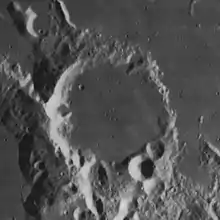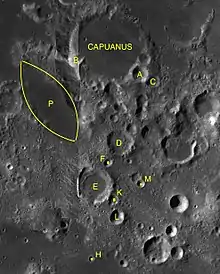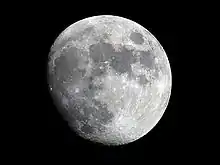Capuanus (crater)
Capuanus is a lunar impact crater that lies along the southern edge of the Palus Epidemiarum. It was named after Italian astronomer F. Capuano di Manfredonia.[1] The outer rim is eroded and indented by lesser crater impacts, with notches in the north, west, and southern parts of the rim. The interior floor has been resurfaced by basaltic lava, which is connected to the surrounding lunar mare by a narrow, crater-formed gap in the northern rim. The floor is particularly notable for the hosting a number of domes, which are believed to have formed through volcanic activity.
 Lunar Orbiter 4 image | |
| Coordinates | 34.1°S 26.7°W |
|---|---|
| Diameter | 60 km |
| Colongitude | 28° at sunrise |
| Eponym | F. Capuano di Manfredonia |
The rim reaches its maximum altitude along the western face, where it merges with ridges along the edge of the mare. To the northeast the rim dips down very close to the surface, and barely forms a curving ridge in the surface. The southeastern rim is overlaid by a pair of craters.
To the north of Capuanus is the western extreme of the wide rille named Rima Hesiodus, which runs to the east-northeast. To the west-northwest is the crater Ramsden, and between Capuanus and Ramsden lies a system of intersecting rilles named the Rimae Ramsden.
Satellite craters

By convention these features are identified on lunar maps by placing the letter on the side of the crater midpoint that is closest to Capuanus.
| Capuanus | Latitude | Longitude | Diameter |
|---|---|---|---|
| A | 34.7° S | 25.6° W | 13 km |
| B | 34.3° S | 27.7° W | 11 km |
| C | 34.9° S | 25.3° W | 10 km |
| D | 36.4° S | 26.2° W | 22 km |
| E | 37.5° S | 27.1° W | 29 km |
| F | 36.9° S | 26.6° W | 8 km |
| H | 39.4° S | 27.2° W | 4 km |
| K | 37.9° S | 26.5° W | 9 km |
| L | 38.3° S | 26.3° W | 11 km |
| M | 37.5° S | 25.6° W | 7 km |
| P | 35.3° S | 28.3° W | 78 km |
References
- "Capuanus (crater)". Gazetteer of Planetary Nomenclature. USGS Astrogeology Research Program.
- Andersson, L. E.; Whitaker, E. A. (1982). NASA Catalogue of Lunar Nomenclature. NASA RP-1097.CS1 maint: ref=harv (link)
- Bussey, B.; Spudis, P. (2004). The Clementine Atlas of the Moon. New York: Cambridge University Press. ISBN 978-0-521-81528-4.CS1 maint: ref=harv (link)
- Cocks, Elijah E.; Cocks, Josiah C. (1995). Who's Who on the Moon: A Biographical Dictionary of Lunar Nomenclature. Tudor Publishers. ISBN 978-0-936389-27-1.CS1 maint: ref=harv (link)
- McDowell, Jonathan (July 15, 2007). "Lunar Nomenclature". Jonathan's Space Report. Retrieved 2007-10-24.CS1 maint: ref=harv (link)
- Menzel, D. H.; Minnaert, M.; Levin, B.; Dollfus, A.; Bell, B. (1971). "Report on Lunar Nomenclature by the Working Group of Commission 17 of the IAU". Space Science Reviews. 12 (2): 136–186. Bibcode:1971SSRv...12..136M. doi:10.1007/BF00171763.
- Moore, Patrick (2001). On the Moon. Sterling Publishing Co. ISBN 978-0-304-35469-6.CS1 maint: ref=harv (link)
- Price, Fred W. (1988). The Moon Observer's Handbook. Cambridge University Press. ISBN 978-0-521-33500-3.CS1 maint: ref=harv (link)
- Rükl, Antonín (1990). Atlas of the Moon. Kalmbach Books. ISBN 978-0-913135-17-4.CS1 maint: ref=harv (link)
- Webb, Rev. T. W. (1962). Celestial Objects for Common Telescopes (6th revised ed.). Dover. ISBN 978-0-486-20917-3.CS1 maint: ref=harv (link)
- Whitaker, Ewen A. (1999). Mapping and Naming the Moon. Cambridge University Press. ISBN 978-0-521-62248-6.CS1 maint: ref=harv (link)
- Wlasuk, Peter T. (2000). Observing the Moon. Springer. ISBN 978-1-85233-193-1.CS1 maint: ref=harv (link)
| Wikimedia Commons has media related to Capuanus (crater). |
